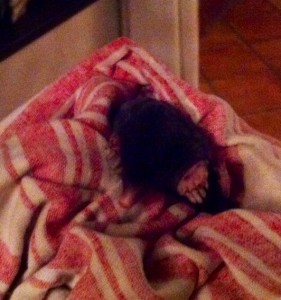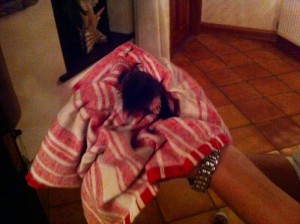As we were locking doors and turning lights off last night, I heard a very faint scratching in the dining room. Turning the lights on, I heard it again and noticed one of the curtains move slightly. Given the fact that the cats continue to bring an array of different rodents and rabbits into the house, usually alive, I cursed as I realised that I was going to have to somehow catch whatever it was. before heading to bed.
Having grabbed a clean tea towel from the kitchen, I crept as quietly as possible towards the curtain. Suddenly a dark brown creature with a rather short tail (had the cats eaten part of it?) scurried from the safety of one curtain to the next. Definitely too big to be a mouse, did that mean that it had to be a rat?? Joy. Moving the curtain to the side, I carefully threw the tea towel over the animal. There was no movement underneath, so it couldn’t be a rodent – they generally race away very quickly (we have become quite expert at ‘rescuing’ all manner of beasts). Gently picking the creature up, as I held it I took the cover off and was absolutely astonished (and delighted) to see that what I was holding was a mole! How on earth it ended up in our dining room I have absolutely no idea, but it was completely unhurt, just utterly terrified I imagine.

Although moles are one of the most common mammals in the UK, they are very rarely seen as they spend almost all their lives underground; most of us only ever get to see the molehills that are formed above the ground when one of the moles’ vertical tunnels reach the surface. The little chap that I was holding had velvety, black, brown short fur, a

slightly cylindrical shaped body, about 14cm long, with a pale pink snout. This snout is covered in bristles that pick up the smallest vibrations and there is a small bone inside it that helps with tunnelling. I couldn’t notice any eyes on the mole but they are tiny and sensitive only to changes in light levels – hence the movement when I turned on the light. Moles don’t have any ears sticking out – great for digging. The snout and stumpy tail are highly sensitive to touch which helps the mole feel its way through the earth whether moving forwards or backwards. For me the most unusual thing about this little mole were its pale pink, shovel like, broad front paws ending in large ivory coloured claws – perfect for digging tunnels through earth rather than carpet. Because of its cylindrical shape without anything sticking out from its body, the mole can dig and squeeze easily through tunnels. In fact they spend most of their life underground where they eat, sleep, breed and move around their network of tunnels from a central nest. Our visiting mole was taken back to the earth by a hedgerow and I hope will stay underground for the rest of his life, although I am delighted that he did visit us, albeit briefly.



